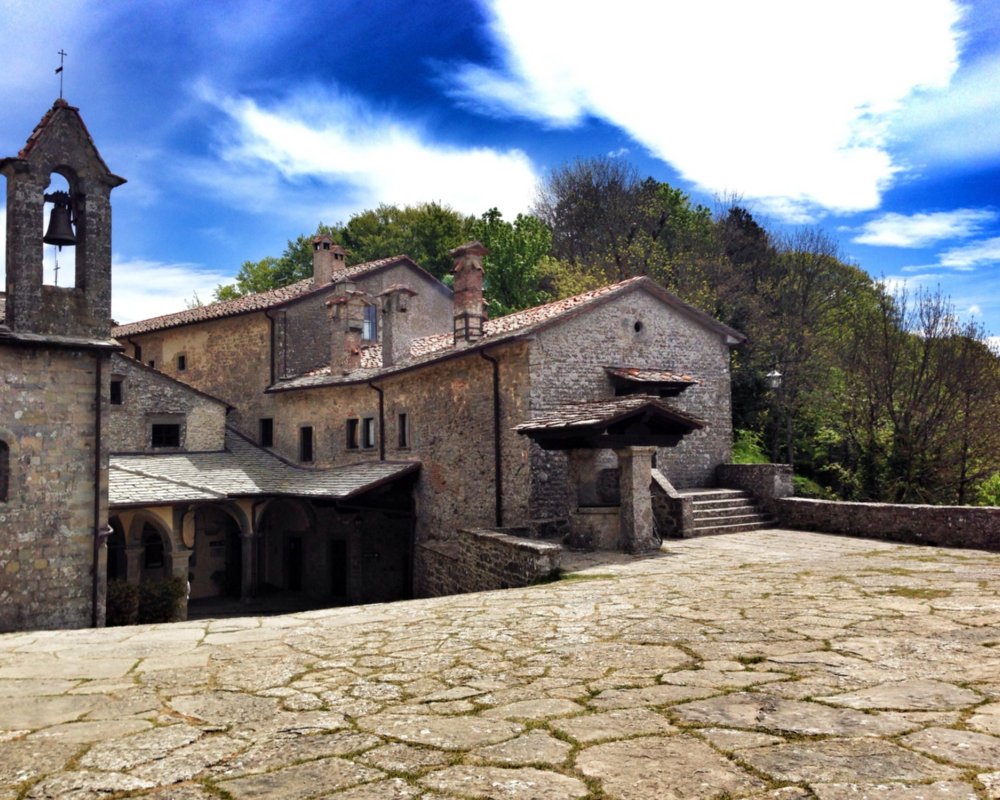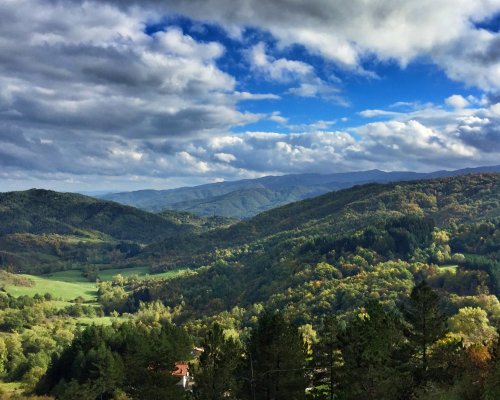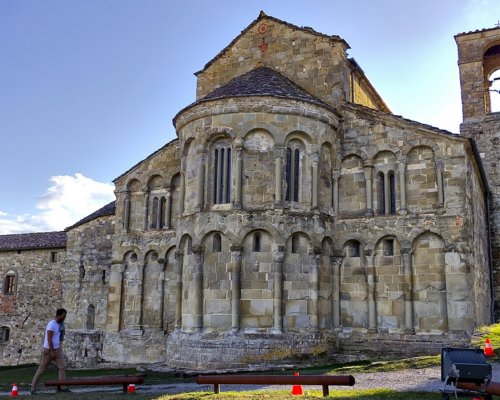Immerse yourself in the nature of Tuscany
The Casentino Valley is nestled in the Apennines between the cities of Florence and Arezzo. It’s a very fascinating place because of the monumental forests, awarded as one of the most beautiful places in Autumn in Italy. The area is also renowned for the peaceful and spiritual hermitages on top of the mountains like Camaldoli.
The suggested itinerary is good for all seasons but if you go during Autumn you may admire the stunning fall foliage of Casentino, while in Summer you may stay “al fresco” and escape from the typical Italian Summer heat.
Our itinerary starts where the Casentino region starts, i.e. at Passo della Consuma, the borderline between the provinces of Florence and Arezzo. The brown and large road sign indicating “Passo della Consuma” and the altitudine at 1.050 meters above the sea level is one of the most representative postcards of the area. At the shop nearby, don’t miss the crunchy schiacciata with mushrooms, that is the perfect companion for an authentic roadtrip in Casentino.
From there follow the panoramic SR70 and arrive to Stia. This little town has a very peculiar square, Piazza Tanucci, that is long but narrow and framed by porticos. In 1996 it was the set of the famous and hilarious Italian comedy film The Cyclone by Tuscan film director Leonardo Pieraccioni. Next stop is at the Wool Museum, or Museo della Lana, where you discover the traditional art of panno del casentino: it’s a typical and rustic wool colored with vivid orange or green that has been produced since the 14th century in the area of Stia-Pratovecchio.
Visit the ruins of the remarkable Castle of Romena, located just a few kilometers from the town of Pratovecchio, birthplace of Paolo Uccello. The castle has a long and important history related to the Guidi counts who ruled the Casentino for centuries and was mentioned by Dante Alighieri within the Divine Comedy. On the way to the castle stop by the Parish Church of Romena, dating back to the 12th century and preserving its original Romanesque style.
Our itinerary starts where the Casentino region starts, i.e. at Passo della Consuma, the borderline between the provinces of Florence and Arezzo. The brown and large road sign indicating “Passo della Consuma” and the altitudine at 1.050 meters above the sea level is one of the most representative postcards of the area. At the shop nearby, don’t miss the crunchy schiacciata with mushrooms, that is the perfect companion for an authentic roadtrip in Casentino.
From there follow the panoramic SR70 and arrive to Stia. This little town has a very peculiar square, Piazza Tanucci, that is long but narrow and framed by porticos. In 1996 it was the set of the famous and hilarious Italian comedy film The Cyclone by Tuscan film director Leonardo Pieraccioni. Next stop is at the Wool Museum, or Museo della Lana, where you discover the traditional art of panno del casentino: it’s a typical and rustic wool colored with vivid orange or green that has been produced since the 14th century in the area of Stia-Pratovecchio.
Visit the ruins of the remarkable Castle of Romena, located just a few kilometers from the town of Pratovecchio, birthplace of Paolo Uccello. The castle has a long and important history related to the Guidi counts who ruled the Casentino for centuries and was mentioned by Dante Alighieri within the Divine Comedy. On the way to the castle stop by the Parish Church of Romena, dating back to the 12th century and preserving its original Romanesque style.
Kick off your second day in Casentino by visiting the Castle of Poppi located in the center of Poppi, lovely town still enclosed in the medieval walls. The castle was the residence of the Conte Guidi family and now is the residence of the ghost of Matelda, young wife of the Count Guidi. Legend has is that Countess Matelda used to kill her young lovers after spending one night together by pushing them into a deadly passage in the Torre del Diavolo, literally the Devil’s Tower. People noticed the disappearance of several young men after visiting the castle; one day they decided to wall up Matelda in the tower and left her to starve, but it seems that her ghost is still leaving in the castle.
After visiting the lovely town of Poppi drive to Camaldoli, one of the most impressive sanctuaries of Tuscany. Camaldoli is an active monastic complex that includes the hermitage of Camaldoli, located in the middle of the forest. The hermitage is a magic place and we recommend you visit all the areas open to the public, including the shop where you can buy handmade products by the monks.
The Hermitage of Camaldoli is located within the National Park of Foreste Casentinesi: this green and peaceful corner of Tuscany preserves a unique nature heritage. The starting point for your visit to this National Park is Badia Prataglia, located in the center of the park. This town is strongly related to the forest and to the Camaldoli monastery because of the traditional woodwork.
Many hiking trails in the Foreste Casentinesi start from Badia Prataglia, that we recommend to visit also in Autumn when the red, orange and yellow color the forest.
Kick off your second day in Casentino by visiting the Castle of Poppi located in the center of Poppi, lovely town still enclosed in the medieval walls. The castle was the residence of the Conte Guidi family and now is the residence of the ghost of Matelda, young wife of the Count Guidi. Legend has is that Countess Matelda used to kill her young lovers after spending one night together by pushing them into a deadly passage in the Torre del Diavolo, literally the Devil’s Tower. People noticed the disappearance of several young men after visiting the castle; one day they decided to wall up Matelda in the tower and left her to starve, but it seems that her ghost is still leaving in the castle.
After visiting the lovely town of Poppi drive to Camaldoli, one of the most impressive sanctuaries of Tuscany. Camaldoli is an active monastic complex that includes the hermitage of Camaldoli, located in the middle of the forest. The hermitage is a magic place and we recommend you visit all the areas open to the public, including the shop where you can buy handmade products by the monks.
The Hermitage of Camaldoli is located within the National Park of Foreste Casentinesi: this green and peaceful corner of Tuscany preserves a unique nature heritage. The starting point for your visit to this National Park is Badia Prataglia, located in the center of the park. This town is strongly related to the forest and to the Camaldoli monastery because of the traditional woodwork.
Many hiking trails in the Foreste Casentinesi start from Badia Prataglia, that we recommend to visit also in Autumn when the red, orange and yellow color the forest.
On your way to the sanctuary of La Verna, stop by the tiny Corezzo: this village counts just few inhabitants that are proud to continue the tradition of tortello alla lastra. This is a big tortello, i.e. a large piece of handmade pasta filled with smashed potatoes savored with onion, tomato and other spices. Beyond the large size, its peculiarity is that the tortello is cooked on the grill and not boiled into the water. Every year in mid August Corezzo hosts the famous “Sagra del Tortello di Corezzo”.
Now it’s time to visit the Sanctuary of La Verna, built on a rock overlooking the Foreste Casentinesi. The sanctuary was founded where Saint Francis received his stigmate in 1224; it’s a mystic place where Nature meets spirituality and deeply touches your soul. If you like hiking we recommend you reach La Verna by walking along the “Nature Trail and Bosco delle fate”. The trail starts in Beccia, where you can park your car, it is about 4.5 kilometers and passes through the forests underneath the sanctuary called the fairies’ forest.
In Chiusi della Verna, a few kilometres from the sanctuary, we recommend to visit the Podesteria. This is the place where Michelangelo, master of the Renaissance, lived with his family in his youth. The big rock next to the house inspired Michelangelo for the rock of Adam in the Sistine Chapel.
Last but not least end your journey visiting the town of Bibbiena. The city center is rich in beautiful buildings like the 16th century Palazzo Dovizi, and the Church of San Lorenzo preserving two terracotta works by Andrea della Robbia depicting the Deposition and the Adoration. Don’t miss the Archaeological Museum of Casentino at Palazzo Niccolini preserving a large collections of valuable findings from the Prehistory to the late Roman era.
On your way to the sanctuary of La Verna, stop by the tiny Corezzo: this village counts just few inhabitants that are proud to continue the tradition of tortello alla lastra. This is a big tortello, i.e. a large piece of handmade pasta filled with smashed potatoes savored with onion, tomato and other spices. Beyond the large size, its peculiarity is that the tortello is cooked on the grill and not boiled into the water. Every year in mid August Corezzo hosts the famous “Sagra del Tortello di Corezzo”.
Now it’s time to visit the Sanctuary of La Verna, built on a rock overlooking the Foreste Casentinesi. The sanctuary was founded where Saint Francis received his stigmate in 1224; it’s a mystic place where Nature meets spirituality and deeply touches your soul. If you like hiking we recommend you reach La Verna by walking along the “Nature Trail and Bosco delle fate”. The trail starts in Beccia, where you can park your car, it is about 4.5 kilometers and passes through the forests underneath the sanctuary called the fairies’ forest.
In Chiusi della Verna, a few kilometres from the sanctuary, we recommend to visit the Podesteria. This is the place where Michelangelo, master of the Renaissance, lived with his family in his youth. The big rock next to the house inspired Michelangelo for the rock of Adam in the Sistine Chapel.
Last but not least end your journey visiting the town of Bibbiena. The city center is rich in beautiful buildings like the 16th century Palazzo Dovizi, and the Church of San Lorenzo preserving two terracotta works by Andrea della Robbia depicting the Deposition and the Adoration. Don’t miss the Archaeological Museum of Casentino at Palazzo Niccolini preserving a large collections of valuable findings from the Prehistory to the late Roman era.


